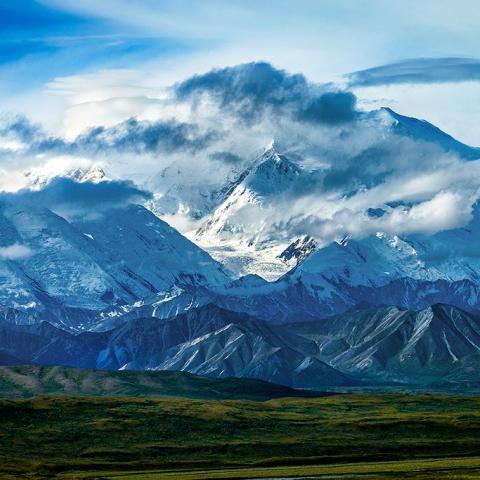
A grizzly bear in the area of the Savage River Campground was put down by rangers due to having lost its fear of humans/NPS file photo of view from Savage River Campground
A badly malnourished grizzly boar, one struggling with infirmities and which had connected park visitors with food, was put down by Denali National Park rangers and wildlife staff who concluded that the bear wasn't healthy enough to sustain aversion training to instill a fear of humans.
The last time park management killed a bear conditioned to human food was during the summer of 1980.
The bear, which had led to recent backcountry closures in the Savage River area of the park, was captured Tuesday night. Wildlife staff initially planned to collar the bear and release it, in conjunction with aversive conditioning, in the Savage River parking lot. Because the bear had not been seen in a couple of weeks, it was considered reasonable to conduct a “hard release,” once it had been collared, a park release said.
However, due to the bear’s physical condition park officials determined the best course of action was to destroy the bear.
“The bear was in terrible physical condition and had a deformity,” said Dave Schirokauer, Denali's park resources and science team leader.
Prior to its capture, the bear had sustained injuries including a broken and badly infected front left leg and a broken nose. In addition, the bear had a deformity; an extra upper-left canine tooth. It also was severely underweight. A typical healthy three year-old male grizzly should weigh about 200-250 pounds, whereas this bear weighed only 130 pounds, the park said.
Because the bear was so thin, wildlife staff could not properly fit the bear with a collar, and they determined it was unlikely a collar would have stayed on for long.
To release the bear, staff would have been required to collar it and subject it to strong aversive conditioning; this is called a “hard release.” The park’s wildlife biologists concluded hitting the bear with multiple aversive rounds as it was released would potentially have compromised the bear further and possibly resulted in additional injuries, given its poor condition and lack of fat.
Denali staff was first alerted to this bear’s behavior in late-June when it was reported the bear had charged vehicles in the Primrose area and charged visitors in the Savage River area along the Denali Park Road. On June 22, the bear approached and charged several hikers on the Savage Alpine Trail. After one of the hikers threw a daypack, hoping to distract it, the bear was rewarded with human food from the pack.
Following the park’s bear management plan, the area was closed and staff used aversive conditioning techniques, including shooting the bear with bean bags. The area reopened on July 1 when the bear had not been seen for five days, in accordance with the Denali Bear Human Conflict Management Plan, and it seemed the aversive conditioning techniques were successful and the bear moved away from the area.
The area was closed again that day when the bear bit and scratched a hiker on the Savage Alpine Trail. Two days later, the bear was observed in the Savage River Campground, where wildlife staff hit it with bean bags. The bear ran from the area. Later that day it was discovered that the bear had damaged two tents in Savage River Campground and the campground was closed to tent camping.
When the bear had not been seen for two weeks, staff began implementing a “soft opening” plan on July 18. Several scheduled openings were delayed last week when staff received reports of a bear, or bears, in the area. Staff was not able to confirm whether or not these sightings were the problem bear, but they decided to be prudent and delay further openings. Then, on Tuesday, park staff was able to positively identify this bear. A helicopter was called in and the bear was captured Tuesday night and euthanized Wednesday morning.
All areas previously closed as a result of this bear’s behavior are open. However, NPS staff knows of at least seven other bears currently in the Mt. Healy, Savage River, and Primrose Ridge areas. Park officials are asking everyone to continue to exercise caution and bear-safe practices while hiking in the park.
Decisions to kill wildlife are not made lightly in Denali National Park, or any other national park, and this series of events has impacted many of the staff involved.
“We are all emotionally impacted and physically and emotionally drained by this series of events,” said Schirokauer. “Denali wildlife staff and ranger(s)…pride themselves on managing the park in a manner that is least impactful to wildlife.”
He also said that when an animal requires destruction due to people’s actions, it is very hard on park staff, and “we take the loss of the bear personally. We are also not accustomed to it; it’s been 36 years since the park has killed a food-conditioned bear.”
The park’s landscape is lonelier with this bear gone; however, human safety is paramount to the NPS. Keeping bears wild and people safe is a fundamental goal in Denali National Park. Unfortunately, when bears obtain human food or become bold or aggressive towards humans, this goal typically becomes unattainable.




 Support Essential Coverage of Essential Places
Support Essential Coverage of Essential Places







Add comment